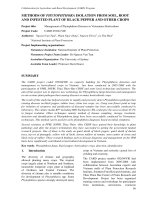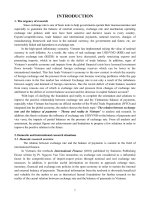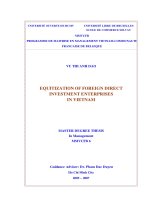Flower biology of black pepper (Piper nigrum) in Vietnam
Bạn đang xem bản rút gọn của tài liệu. Xem và tải ngay bản đầy đủ của tài liệu tại đây (1.67 MB, 6 trang )
VAAS - YAAS Cooperation on Cross border Economics study
accounting for 72.3% of the households. e type of
intercropping avocado has only recently developed,
accounting for more than 8% of the households.
Multiple intercropping model had above 11.7% of the
households.
- Type of intercropping durian with a spacing of
12 ˟ 12 m and 12 ˟ 15 m for co ee yield of over 3 tons/ha
and durian productivity of over 60 kg per tree,
economic e ciency higher than pure co ee planting
from 75.89 to 96.85%.
- Type of intercropping pepper with spacing of
3 ˟ 6 m, 6 ˟ 6 m for co ee yield of 3 tons/ha and pepper
yield of 2.7 kg per plant, economic e ciency higher
than pure planting from 100.25 to 120.45%.
- Type of intercropping avocado with all spacing
had co ee yield over 3 tons/ha and the productivity
of avocado over 30 kg per tree, economic e ciency
increased from 39.58 to 83.24%.
- Type of intercropping cashew with all spacing had
low co ee yield and economic e ciency was not
signi cantly increased comparing to pure co ee planting.
Recommendations
- On the basis of co ee as the main crop, to increase
income per area unit and ensure sustainable co ee
cultivation, recommending reasonable intercropping,
ensuring the harmonious development of crops, the
average co ee yield is over 3 tons per ha and the
economic e ciency is higher than that of pure co ee
planting.
- Recommending durian and avocado intercroping
with the spacing of 12 ˟ 12 m and 12 ˟ 15 m; pepper
intercroping with the spacing of 3 ˟ 6 m and 6 ˟ 6 m.
e recommended density was the same as in the
intercropping process. It is not recommended to
develop cashew intercroping.
REFERENCES
Department of Crop Production, 2018. Current status
and orientation of intercropping in sustainable co ee
production organized by the Ministry of Agriculture
and Rural Development and the Dak Lak Provincial
People’s Committee, April 19, 2018 in Buon Ma
uot city, documents for conferences.
Dinh
i Nha Truc, Nguyen Vu Ky, 2017.
e
investigation on types of intercropping system of
perennial cash crops in robusta co ee plantations
in the Central Highlands. Sustainable agricultural
transformation project (VnSAT).
Dinh i Nha Truc, Nguyen Vu Ky, 2018. Process of
intercropping pepper, avocado, durian trees in robusta
co ee garden. Western highlands Agriculture &
Forestry Science Institute - Vietnam Academy of
Agricultural Sciences.
Nguyen Xuan Hoa, Dang Dinh Duc Phong, Nguyen
Van Phuong, 2016. Evaluation of agroforestry systems
on co ee gardens in Dak Lak and Lam Dong. Western
highlands Agriculture & Forestry Science Institute.
Vietnam Academy of Agricultural Sciences.
Nguyen Van uong, Trịnh Xuan Hong, Phan Viet
Ha, 2001. Agroforestry systems in Daklak province:
ecological impacts and econnomic e ects. Western
highlands Agriculture & Forestry Science Institute.
Date received: 9/10/2019
Date reviewed: 15/11/2019
Reviewer: Dr. Nguyen Van uong
Date accepted for publication: 22/11/2019
FLOWER BIOLOGY OF BLACK PEPPER (PIPER NIGRUM) IN VIETNAM
Duong
Nguyen Tran Quyen1,*, Tran i Dieu Hien1,
i Oanh , Nguyen Quang Ngoc1, Nguyen i Nhung1
1
Abstract
A study on ower biology of black pepper (Piper nigrum) was carried out to provide important understanding in
ower biology which is vital to breeding and hybridization studies in Vietnam. ree varieties namely Vinh Linh,
Phu Quoc and SRLK have been used for this study. e results showed that it takes about 242 days to 270 days from
spike appearance to fruit ripening. e longest period is fruit development and fruit maturity. Anther dehiscence
of Vinh Linh and Phu Quoc occurs at around 7:00 pm to 8:00 pm. However, SRLK is earlier at 4:00 pm to 5:00 pm.
Sigma receptivity happens 1.8 days to 2.8 days a er anther dehiscence. Stigma remains receptive from 4 days to
6 days and up to 10 days.
Keywords: Piper nigrum, ower biology, anther dehiscence, stigma receptivity
1
*
Pepper Research and Development Centre - Vietnam
Corresponding author: Nguyen Tran Quyen. Email:
19
Vietnam Academy of Agricultural Sciences (VAAS)
INTRODUCTION
Black pepper (Piper nigrum L., Piperaceae), the King
of Spices, is one of the most important spices in over
the world. Black pepper is used as culinary spice as
well as medicine and cosmetics industries.
Black pepper originated in the Western Ghats of Kerala
and the history of this spice is closely linked to the
history of India (Parry, 1969; Rosengarten 1973). In
early nineteen century, black pepper was introduced
to Vietnam, and then became popular a er 1975.
Currently, the crop is mainly cultivated in Central
Highlands and South-eastern region with total area
was about 152,000 hectares and total production was
235,889 tons which have made Vietnam become the
biggest pepper producer in the world.
Breeding study is still very limited so far, and there
is no varieties have been released. Farmers only use
local varieties such as Vinh Linh and Loc Ninh which
are high yielding varieties but very susceptible to
Phytopthora capsici and nematodes. Limited work
in breeding as well as hybridization may results of
lacking of fundamental information.
Hybridization is considered a good breeding
methodology to create new variety that is able to resist
to Phytophthora capsici and/or nematodes. Successful
hybridization is resulted from understanding of ower
biology. is paper aims to provide information in
di erent stages of spike development as well as anther
dehiscence and stigma receptivity.
MATERIALS AND METHODS
Materials
Vinh Linh, Phu Quoc and SRLK varieties have been
used for this study. Semi-hardwood cuttings of these
varieties were collected from mother garden at Pepper
Research and Development Centre.
Soil moisture meter: checking soil moisture in pot.
Head magni er: monitoring anthers, stigmas.
Microscope: identifying pollens.
Methods
Preparation of plants
Semi-hardwood fruiting branches are harvested from
disease - free garden. en, they are planted in pots
with 40 cm of diameter and 40 cm of height. Fi een
pots per variety are prepared (forty ve pots in total).
e pots are lled with potting mixtures which are
contain cow dung, coir pit, top soil and river sand
20
Journal of Vietnam Agricultural Science and Technology - No.1(4)/2019
with the ratio of 1 : 1 : 1 : 1. e pots are placed in
green house with shade conditions. A er one month
of planting, semi-hardwood branches produce shoots
and rooted. Water and fertilizers are applied to keep
the plants healthy and good growth. A er four to
ve months of planting, the plant is able to produce
owers and ready for experiment.
Investigate di erent development stages of spikes
Only Vinh Linh variety was used for this experiment.
At the beginning of experiment, water stress is
applied to facilitate ower formation. is means that
the plants were le in green house without watering.
Soil moisture in the pots was recorded daily by soil
moisture meter to make sure soil moisture does not
reach to wilting point. In addition, daily observations
all treatments must be done to ensure all plants are
healthy.
A er 31 days of water stress, 3 liters of clean water per
pot will be applied every 7 days. A er 21 days of resupply water, pepper spikes will be appeared.
Forty ve spikes were randomly selected to
investigate number of days in di erent stages of
spike development: Stage 1: Re-supply water; Stage 2:
Spike appearance; Stage 3: Spike development; Stage
4: Pollination and fertilization; Stage 5: Fruit setting;
Stage 6: Fruit development; Stage 7: Fruit maturity;
Stage 8: Fruit ripening.
Anther dehiscence
Vinh Linh, Phu Quoc and SRLK varieties were used for
this study. Vinh Linh and Phu Quoc are local varieties
which high yield and good quality while SRLK is
imported variety which is good development. Around
y anthers per variety at the pre-dehisced stage were
selected.
en, observations were done every one
hour to identify anther dehiscence. Magni er was
used to observe powder (pollens). Finally, released
pollens were con rmed by microscope observations.
Stigma receptivity
ree above varieties also used for this study. e
receptive periods were di erentiated by Chen et al.
(2018) (Figure 1).
Time and place of the study
e study was conducted in 2018, at Pepper Research
and Development Centre (PRDC).
e location
details are 13o57’32’’ N 108o0’57’’E, 790 m of elevation,
Pleiku city, Gia Lai, Vietnam.
VAAS - YAAS Cooperation on Cross border Economics study
A
B
C
Figure 1. Stages of stigma
Source: Chen et al. (2018).
Note: Stage 1 (A): First appearance of stigma (days); Stage 2 (B): Elongation and spreading of stigma (days); Stage 3 (C):
Complete emergence and wide spreading of stigma (days).
RESULTS AND DISCUSSION
Spike characteristics
e in orescence in black pepper is a glabrous,
liform, pendulous spike borne opposite to the leaves
on plagiotropic branches (Parthasarathy et al., 2007).
from each side of ovary (Figure 4, 5). In addition,
black pepper also has female owers but proportion
is very limited.
Similarly to other piper nigrum, Vinh Linh, Phu Quoc
and SRLK are pendulous spike. SRLK has longest
spike which is about 18.5 cm, following by Vinh Linh
around 10.4 cm. Phu Quoc has shortest spike which
is about 8.4 cm.
Flowers
In Vietnam (Central Highlands and Southeast),
owering season generally starts at pre-monsoon
(June - July) when soil gets moist. High air humidity
is considered the best conditions for pollination and
fertilization.
Flowers are borne in the axils of ovate, eshy bracts
in long spikes, which are pendant, singular in nature,
and appear opposite to the leaves on the plagiotropic
branches (Parthasarathy et al., 2007).
Black pepper owers are mainly bisexual; one ower
contains one ovary and two stamens which are borne
Figure 3. Female ower
a
b
c
Figure 2. Spikes
Note: a: Vinh Linh; b: Phu Quoc; c: SRLK.
High percentage of bisexual ower will result in
high yield. For example, high yielding varieties in
India such as Panniyur 3 (99.90% of bisexual ower),
Panniyur 1 (99.20%), and Subhakara (99.00%).
Similarly, Vinh Linh has highest percentage of
bisexual owers with 97.30%, following by Phu Quoc
and SRLK around 95.20% and 93.45%, respectively.
Figure 4. Bisexual ower
Figure 5. A Vinh Linh bisexual ower
Source: Parthasarathy et al. (2007).
Note: St: stamen; ov: ovary; lob: lowest bract; ub: upper bract; lb: lower bract.
21
Vietnam Academy of Agricultural Sciences (VAAS)
e process from spike appearance to fruit ripening
of Vinh Linh takes about 242 days to 270 days,
including 8 stages (Figure 6). At the beginning of the
process, spike is fully appeared a er 28 - 30 days of
water supply. en, it takes about 18 days to 20 days
for full development of spike, following by 12 days to
13 days of pollination and fertilization. Fruit setting
only takes 6 - 9 days; in contrast fruit development
lasts from 120 days to 130 days, followed by a period
of 34 - 38 days of maturity. Finally, fruits need 25 days
to 30 days to ripen.
e above results are similar to the eld conditions
Journal of Vietnam Agricultural Science and Technology - No.1(4)/2019
and other study. In eld conditions in Vietnam,
owering season generally starts from June and July.
en, fruit development and maturity is from August
to December.
e fruits are ripened and ready to
harvest in March. In India, it takes about 180 days to
240 days from owering to maturity. Late maturity
may be due to of cool weather (Ravindran, 2000).
KAU (1978) also concluded that it takes about three to
four weeks for full spike appearance. Pollination and
fertilization period is about 8 - 24 days, depending
varieties and weather conditions (KAU (1978) cited
by Ravindran, 2003).
0 day
Stage 1
Re-supply
water
28 - 30 days
Stage 2
Spike
appearance
18 - 20 days
Stage 3
Spike
development
6 - 9 days
Stage 5
Fruit
setting
120 - 130 days
Stage 6
Fruit
development
34 - 38 days
Stage 7
Fruit
maturity
12 - 13 days
Stage 4
Pollination
fertilization
25 - 30 days
Stage 8
Fruit
ripening
Figure 6. Di erent stages of spike and fruit development in green house
Anther dehiscence
Black pepper is mainly self-pollinated. Pollens can be
transported from one ower to others. In one bisexual
ower, stigma will appear rst and the time interval
depends on the cultivars. Generally, the stigma
22
emergence can be noticed in 10 - 20 days, though
there are cultivars where the stigma emergence takes
place in around ve days a er full spike emergence.
It takes about 5 - 15 days for completion of stigma
emergence. e period of receptivity of stigma varies
VAAS - YAAS Cooperation on Cross border Economics study
from 3 - 9 days, and the receptive period of stigma in
the rst opened basal owers is longer and the period
gradually decrease in owers opening later in the
developmental stage (KAU, 1978).
e results showed that anther dehiscence in Vinh
Linh and Phu Quoc varieties starts at the same
time at 7:00 pm to 8 pm. However, SRLK is earlier
at 4:00 pm to 5:00 pm (nursery conditions in May
and Junes in Central Highlands). Chen et al. (2018)
concluded that the median time of anther dehiscence
was between 11:00 pm to 12:00 pm for ten cultivars
namely Semongok Aman, Kuching, Semongok Emas,
Semongok Perak, Semongok 1, Nyerigai, India,
Lampung Daun Lebar, Sarikei and Yong Petai.
e author further supported that time of anther
dehiscence is signi cantly a ected by weather
conditions. For example, anther dehiscence for
Semongok Aman takes longer in March and April
compared to May, June and July. ese di erences
may be due to level of relative humidity and rainfalls
where March and April has more rainfall and higher
relative humidity compared to May, June and July.
Chen et al. (2018) also investigated pollen viability of
the above ten varieties. It is concluded that pollens are
more viable between ve and ten hours a er anther
dehiscence.
Observations of sigma development shows that it
takes about 4 days 6 days from stage 1 ( rst appearance
of stigma) to stage 3 (complete emergence and wide
spreading of stigma). Vinh Linh takes longest time of
stigma receptivity with 6 days, following SRLK with 5
days and Phu Quoc is only 4 days.
is outcome is also similar to other one. Chen et al.
(2018) also concluded that it take about 7 days to
10 days from stage 1 to stage 3 (varieties: Semongok
Aman , Kuching, Semongok Emas, Semongok Perak,
Semongok 1, Nyerigai, India, Lampung Daun Lebar,
Sarikei and Yong Petai). Details are: Stage 1: rst
appearance of stigma (one day); Stage 2: elongation
and spreading of stigma (1 - 2 days) and Stage 3:
complete emergence and wide spreading of stigma (2
- 3 days). e author also recommended that stage 2
and stage 3 had better receptivity than stage 1.
Early study also concluded that the best time for stigma
receptivity is ve days a er emergence (stage 2, 3)
(Purseglove, 1968) and sigma may receive pollens up
to ten days. Without pollination, stigma surfaces may
remain receptive for a long period (Wetzstein and
Sparks, 1989), spike without pollination, however,
may falling down.
CONCLUSIONS AND RECOMMENDATIONS
Vinh Linh variety needs about 242 days to 270 days
from spike appearance to fruit ripening. e longest
stages are fruit development and fruit maturity.
Anther dehiscence occurs di erently between three
varieties; Vinh Linh and Phu Quoc become dehisced
around 7:00 pm to 8:00 pm. By contrast, SRLK is
earlier at 4:00 pm to 5:00 pm. Stigma receptivity
happens a er 1.8 to 2.8 days of anther dehiscence.
Then, sigma receptivity remains from 4 days to
10 days. e best time for stigma receiving pollens is
to 6 days a er rst stigma appearance.
Figure 7. Time of anther dehiscence in cultivar
Semongok Aman between March and July 2016
Source: Chen et al. (2018).
Stigma receptivity
e results showed that stigma receptivity occur a er
anther dehiscence. is time intervals is signi cant
different between three varieties with 2.7 days
(Vinh Linh), 1.8 days (Phu Quoc) and 2.8 days
(SRLK) a er anther dehiscence. In other words,
anther becomes dehisced and release pollens before
sigma get mature and receive pollens.
It is proposed that pollen collection of Vinh Linh
and Phu Quoc need to be done around 10:00 pm to
12:00 pm. SRLK, however, should be done around
8:00 pm to 10:00 pm. Arti cial pollination should be
done 5 days to 6 days a er rst stigma appearance.
REFERENCES
Chen, Y. S., Dayod, M., & Tawan, C. S., 2018. Anther
Dehiscence, Pollen Viability and Stigma Receptivity
Study on Cultivars of Black Pepper (Piper nigrum L.).
Pertanika Journal of Tropical Agricultural Science,
41 (2): 801-814.
K.A.U., 1978. Annual Report (1977–78). Kerala Agri.
Univ., Vellanikkara, rissur, pp. 122-123.
23
Vietnam Academy of Agricultural Sciences (VAAS)
Parthasarathy, V., Sasikumar, B., Nair, R., & George,
K. J., 2007. Black pepper: botany and horticulture.
Horticultural Reviews-Westport
en New York,
33: 173.
Parry, J. W., 1969. Spices. Vol. I. Chemical Publ. Co. New
York, p. 235.
Purseglove, J. W., 1968. Tropical Crops: Dicotyledons.
Vol. II. Longman, London.
Ravindran, P., 2000. Black pepper: Piper nigrum:
CRC Press.
Journal of Vietnam Agricultural Science and Technology - No.1(4)/2019
Ravindran, P., 2003. Black pepper: Piper nigrum:
CRC Press.
Rosengarten, F. Jr., 1973. e book of spices, Pyramid
books. New York.
Wetzstein, H. Y., & Sparks, D., 1989. Stigma-Pollen
interactions in pecan. Journal America Society
Horticulture Science, 114: 355-359.
Date received: 7/9/2019
Date reviewed: 7/11/2019
Reviewer: Dr. Truong Hong
Date accepted for publication: 22/11/2019
DEVELOPMENT OF POTATO STAPLE FOOD IN ZHEJIANG PROVINCE
OF CHINA FROM THE PERSPECTIVE OF WHOLE VALUE CHAIN
Chao Xiang1, Shengfa Shen1, Liehong Wu1,*
Renxiang Cai2, Zaogui Wu3, Bing Li1
Abstract
Potato is the fourth most important food crop in the world. e potato staple food strategy launched in 2015 has
brought new opportunities for the development of potato industry in China. Zhejiang province has its unique
development strengths and experiences in potato industry though potatoes are neither staple food nor staple crop
in Zhejiang province. In this study, the foundation of the potato staple food development in Zhejiang province was
elucidated from the perspective of the whole value chain involving potato production, process and consumption.
Speci cally, through the measures of varieties breeding for special use, localization of seed potato, regionalization of
planting areas, diverse processing and popularization of staple food products, the implementation of potato staple
food was gradually accelerated and the potato industry was further upgraded. In addition, a consumption-oriented
collaborative extension model for the development of potato industry chain was established. e results in this study
will provide an important reference for the sustainable development of potato industry in certain areas in China or
in Asia where there are similar natural resources and dietary habits with Zhejiang province.
INTRODUCTION
Potato is the fourth food crop in the world a er
wheat, rice and corn (Ezekiel et al., 2013; Zhang et al.,
2017). Since potato is highly adaptable to climate
conditions with short growth period, balanced
nutrients and long value chain, it has been widely used
in staple food consumption, process and utilization
(Beals, 2019; Mu et al., 2017; Zhang et al., 2017).
China is the world’s largest potato producer and
consumer (Wang and Zhang, 2004; Scott and Suarez,
2012; Zhang et al., 2017). Around 70% of potato is
taken for fresh consumption (Zhang et al., 2017).
In 2015, the government released the strategy of
potato as staple food, the proposal of potato staple food
strategy o ers an unprecedented opportunity and
points the way for accelerating the industrialization
of potatoes, and followed by a series of problems that
need to be solved, such as the adjustment of variety
structure, the integration of agricultural machinery
and agronomy, the processing technology and
equipment of staple food products, and the change
of consumption habits (Cai, 2016; Cai et al., 2016;
Zhang et al., 2017).
Institute of Crops and Nuclear Technology Utilization, Zhejiang Academy of Agricultural Sciences, Hangzhou, 310021
Agricultural Technology Extension Center of Zhejiang Province, Hangzhou, 310020
3
Seed Management Station of Zhejiang Province, Hangzhou, 310020
* Corresponding author: Liehong Wu
Address: No.198, Shiqiao Rd, Hangzhou, Zhejiang, P, R, China, 310021.
E-mail:
1
2
24









